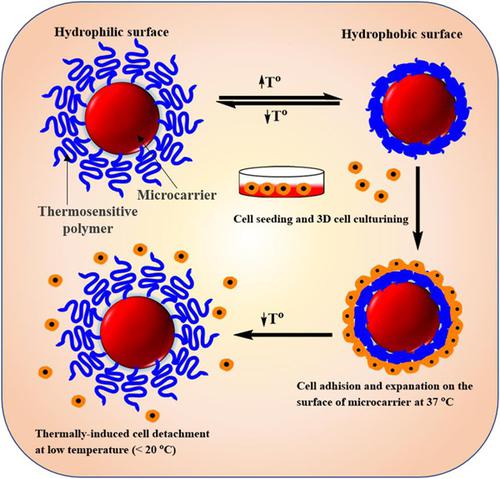当前位置:
X-MOL 学术
›
Biotechnol. Bioeng.
›
论文详情
Our official English website, www.x-mol.net, welcomes your
feedback! (Note: you will need to create a separate account there.)
Preparation of thermosensitive PNIPAm-based copolymer coated cytodex 3 microcarriers for efficient nonenzymatic cell harvesting during 3D culturing
Biotechnology and Bioengineering ( IF 3.5 ) Pub Date : 2021-07-12 , DOI: 10.1002/bit.27885 Haile F. Darge, Shun-Hao Chuang, Juin-Yih Lai, Shuian-Yin Lin, Hsieh-Chih Tsai
Biotechnology and Bioengineering ( IF 3.5 ) Pub Date : 2021-07-12 , DOI: 10.1002/bit.27885 Haile F. Darge, Shun-Hao Chuang, Juin-Yih Lai, Shuian-Yin Lin, Hsieh-Chih Tsai

|
Enzymatic detachment of cells might damage important features and functions of cells and could affect subsequent cell-based applications. Therefore, nonenzymatic cell detachment using thermosensitive polymer matrix is necessary for maintaining cell quality after harvesting. In this study, we prepared thermosensitive PNIPAm-co-AAc-b-PS and PNIPAm-co-AAm-b-PS copolymers and low critical solution temperature (LCST) was tuned near to body temperature. Then, spin coated polymer films were prepared for cell adhesion and thermal-induced cell detachment. The alpha-step analysis and scanning electron microscope image of the films suggested that the thickness of the films depends on the molecular weight and concentration which ranged from 206 to 1330 nm for PNIPAm-co-AAc-b-PS and 97.5–497 nm for PNIPAm-co-AAm-b-PS. The contact angles of the films verified that the polymer surface was moderately hydrophilic at 37°C. Importantly, RAW264.7 cells were convincingly proliferated on the films to a confluent of >80% within 48 h and abled to detach by reducing the temperature. However, relatively more cells were grown on PNIPAm-co-AAm-b-PS (5%w/v) films and thermal-induced cell detachment was more abundant in this formulation. As a result, PNIPAm-co-AAm-b-PS (5%w/v) was further used to coat commercial cytodex 3 microcarriers for 3D cell culturing and interestingly enhanced cell detachment with preserved potential of recovery was observed at a temperature of below LCST. Thus, surface modification of microcarriers with thermosensitive PNIPAm-co-AAm-b-PS could be vital strategy for nonenzymatic cell detachment and to achieve adequate number of cells with maximum cell viability and functionality.
中文翻译:

热敏 PNIPAm 基共聚物涂层 cytodex 3 微载体的制备在 3D 培养过程中用于高效非酶细胞收获
细胞的酶解可能会损害细胞的重要特征和功能,并可能影响随后的基于细胞的应用。因此,使用热敏聚合物基质进行非酶细胞分离对于维持收获后的细胞质量是必要的。在本研究中,我们制备了热敏性 PNIPAm- co -AAc- b -PS和 PNIPAm- co -AAm- b-PS 共聚物和低临界溶解温度 (LCST) 调整到接近体温。然后,制备用于细胞粘附和热诱导细胞脱离的旋涂聚合物薄膜。薄膜的 α 阶跃分析和扫描电子显微镜图像表明,薄膜的厚度取决于分子量和浓度,PNIPAm-co-AAc-b-PS 的范围为 206 至 1330 nm,而 PNIPAm- co -AAc- b -PS 的范围为97.5-497 nm。 PNIPAm- co -AAm- b-PS。薄膜的接触角证实聚合物表面在 37°C 是适度亲水的。重要的是,RAW264.7 细胞在 48 小时内在薄膜上令人信服地增殖到 > 80% 的汇合度,并且能够通过降低温度来分离。然而,在 PNIPAm- co -AAm- b -PS (5%w/v) 薄膜上生长的细胞相对较多,并且该配方中热诱导的细胞分离更为丰富。结果,PNIPAm- co -AAm- b -PS (5%w/v) 被进一步用于涂覆商业 cytodex 3 微载体以进行 3D 细胞培养,有趣的是,在低于LCST。因此,用热敏 PNIPAm 对微载体进行表面修饰co -AAm- b -PS可能是非酶细胞分离的重要策略,并获得足够数量的具有最大细胞活力和功能的细胞。
更新日期:2021-09-12
中文翻译:

热敏 PNIPAm 基共聚物涂层 cytodex 3 微载体的制备在 3D 培养过程中用于高效非酶细胞收获
细胞的酶解可能会损害细胞的重要特征和功能,并可能影响随后的基于细胞的应用。因此,使用热敏聚合物基质进行非酶细胞分离对于维持收获后的细胞质量是必要的。在本研究中,我们制备了热敏性 PNIPAm- co -AAc- b -PS和 PNIPAm- co -AAm- b-PS 共聚物和低临界溶解温度 (LCST) 调整到接近体温。然后,制备用于细胞粘附和热诱导细胞脱离的旋涂聚合物薄膜。薄膜的 α 阶跃分析和扫描电子显微镜图像表明,薄膜的厚度取决于分子量和浓度,PNIPAm-co-AAc-b-PS 的范围为 206 至 1330 nm,而 PNIPAm- co -AAc- b -PS 的范围为97.5-497 nm。 PNIPAm- co -AAm- b-PS。薄膜的接触角证实聚合物表面在 37°C 是适度亲水的。重要的是,RAW264.7 细胞在 48 小时内在薄膜上令人信服地增殖到 > 80% 的汇合度,并且能够通过降低温度来分离。然而,在 PNIPAm- co -AAm- b -PS (5%w/v) 薄膜上生长的细胞相对较多,并且该配方中热诱导的细胞分离更为丰富。结果,PNIPAm- co -AAm- b -PS (5%w/v) 被进一步用于涂覆商业 cytodex 3 微载体以进行 3D 细胞培养,有趣的是,在低于LCST。因此,用热敏 PNIPAm 对微载体进行表面修饰co -AAm- b -PS可能是非酶细胞分离的重要策略,并获得足够数量的具有最大细胞活力和功能的细胞。











































 京公网安备 11010802027423号
京公网安备 11010802027423号